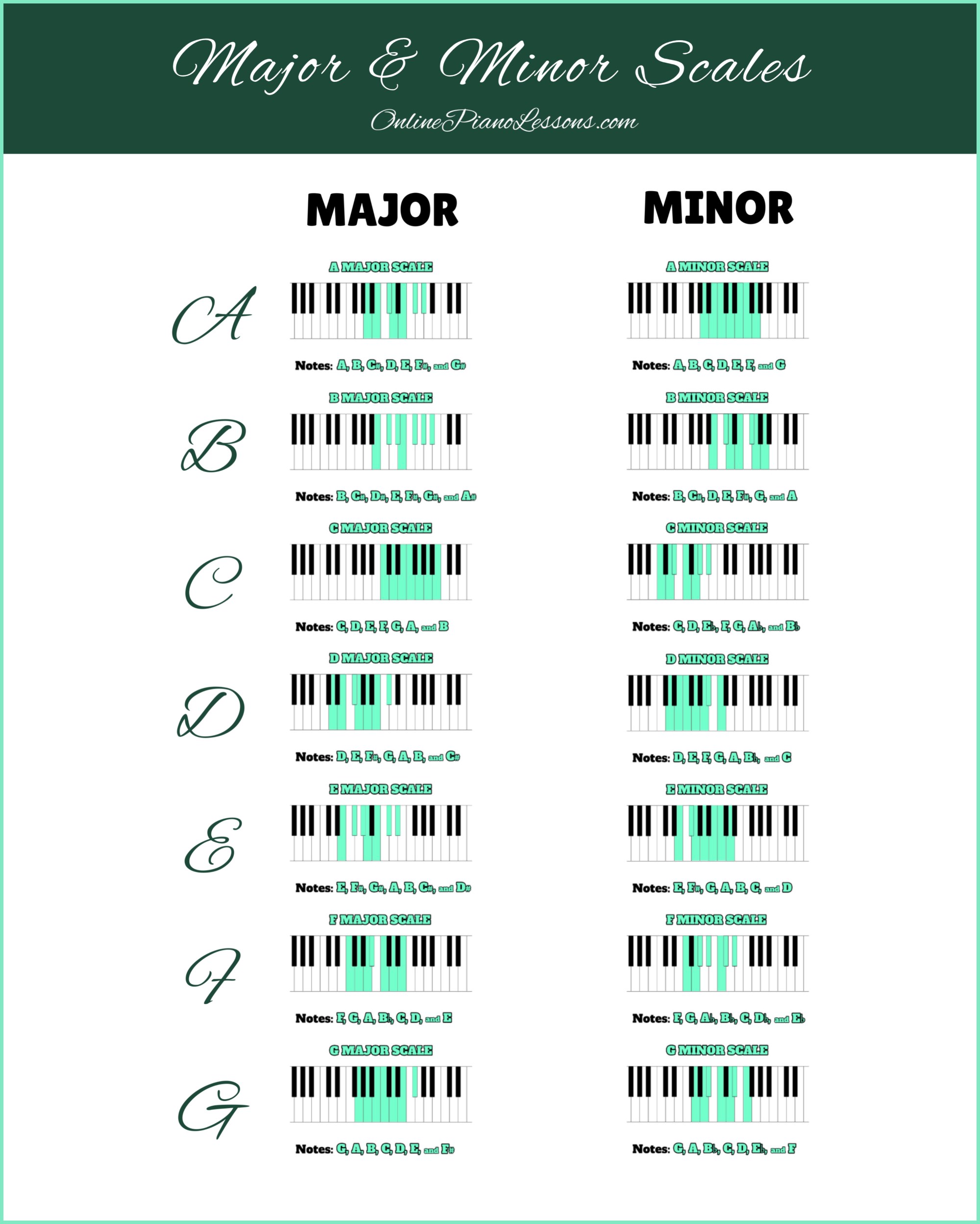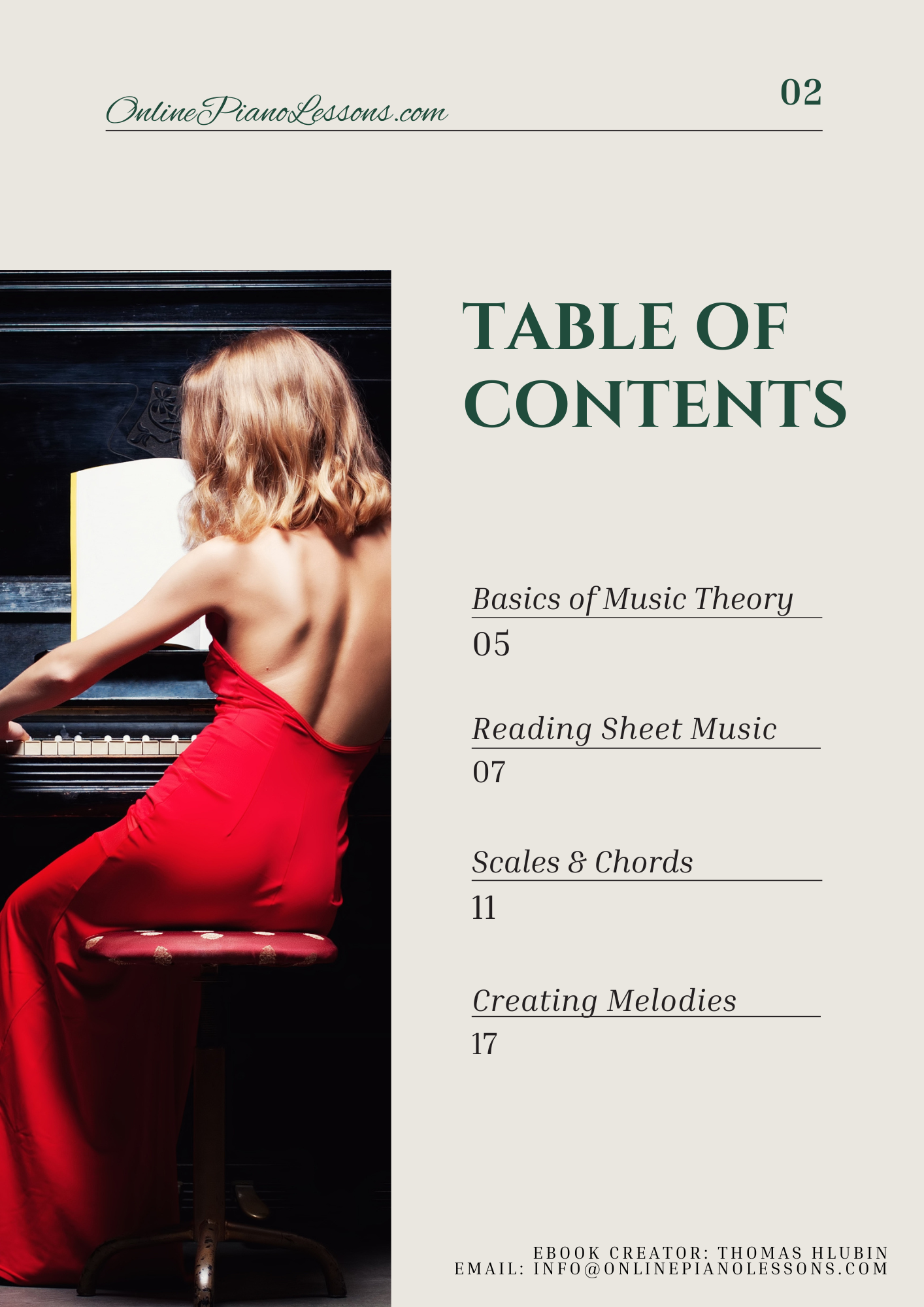✅ Learn Piano + Get 25% off of my online Piano for Beginners Course! Enjoy and happy playing!
Major & Minor Piano Scales Chart
Download Major & Minor Scales Chart
Learning to play the piano isn’t just about hitting the right notes—it’s about understanding how those notes connect to form melodies, harmonies, and songs. One of the most powerful tools for developing this understanding is a Piano Scales Chart. Whether you’re a beginner learning your first keys or an intermediate player refining your skills, mastering piano scales can unlock your true musical potential.
In this in-depth guide, we’ll explore the importance of using a piano scales chart, how to read it, what all the major and minor scales are, and how scales can help you write and play music more confidently. Plus, we’ll show you how to download our free Piano Scales Chart to make learning even easier.
Quick Preview: Unlock your full musical potential with this in-depth guide to the Piano Scales Chart. Learn every major and minor scale, understand their patterns, and discover how a piano scales chart can transform your playing, songwriting, and improvisation skills. Plus, download our free Piano Scales Chart to simplify practice, memorize fingerings, and master every key with confidence
What Is a Piano Scales Chart?
A Piano Scales Chart is a visual reference that shows all the different scales you can play on the piano. It outlines which notes belong to each scale, helping you quickly identify patterns and intervals across the keyboard.
For beginners, this chart acts like a roadmap—it tells you exactly where to place your fingers and which notes belong to a particular scale. For advanced players, it’s a creative tool that can spark new melodies, chord progressions, and improvisation ideas.
Typically, a piano scales chart includes:
- All 12 major scales
- All 12 natural minor scales
- Often the harmonic minor and melodic minor variations
- Fingerings for both hands
- Visual diagrams showing which piano keys to play
Why Learning Scales Matters
Before diving into the details of our Piano Scales Chart, it’s important to understand why scales matter. Every song you’ve ever heard—whether it’s pop, jazz, classical, or blues—is based on scales. They form the foundation of melody, harmony, and rhythm.
Here’s how scales benefit your playing:
- Improved Finger Strength & Coordination
Practicing scales trains your hands to move fluidly and independently, building strength and agility across the keyboard. - Better Ear Training
Scales help your ear recognize musical patterns and pitch relationships, making it easier to play by ear. - Easier Song Learning
Once you know your scales, you’ll quickly recognize the notes and chords used in most songs. - Improvisation & Songwriting
Understanding scales allows you to experiment with melodies and create your own music more freely. - Confidence & Musical Freedom
When you know your way around the keyboard through scales, you stop guessing and start expressing.
The 12 Major Scales on the Piano
Let’s start with the major scales — the most commonly used in Western music. Each major scale follows the same pattern of whole and half steps:
Pattern: Whole, Whole, Half, Whole, Whole, Whole, Half
Here are all 12 major scales:
| Major Scale | Notes |
|---|---|
| C Major | C, D, E, F, G, A, B |
| G Major | G, A, B, C, D, E, F♯ |
| D Major | D, E, F♯, G, A, B, C♯ |
| A Major | A, B, C♯, D, E, F♯, G♯ |
| E Major | E, F♯, G♯, A, B, C♯, D♯ |
| B Major | B, C♯, D♯, E, F♯, G♯, A♯ |
| F♯ Major | F♯, G♯, A♯, B, C♯, D♯, E♯ |
| C♯ Major | C♯, D♯, E♯, F♯, G♯, A♯, B♯ |
| F Major | F, G, A, B♭, C, D, E |
| B♭ Major | B♭, C, D, E♭, F, G, A |
| E♭ Major | E♭, F, G, A♭, B♭, C, D |
| A♭ Major | A♭, B♭, C, D♭, E♭, F, G |
Each of these scales has its own unique mood and sound. For instance, C Major feels bright and open, while E♭ Major has a warm, soulful quality often used in ballads and jazz.
The 12 Natural Minor Scales on the Piano
Now let’s look at the minor scales, which create a more emotional or melancholic tone. The natural minor scale follows this pattern:
Pattern: Whole, Half, Whole, Whole, Half, Whole, Whole
Here are all 12 natural minor scales:
| Minor Scale | Notes |
|---|---|
| A Minor | A, B, C, D, E, F, G |
| E Minor | E, F♯, G, A, B, C, D |
| B Minor | B, C♯, D, E, F♯, G, A |
| F♯ Minor | F♯, G♯, A, B, C♯, D, E |
| C♯ Minor | C♯, D♯, E, F♯, G♯, A, B |
| G♯ Minor | G♯, A♯, B, C♯, D♯, E, F♯ |
| D♯ Minor | D♯, E♯, F♯, G♯, A♯, B, C♯ |
| A♯ Minor | A♯, B♯, C♯, D♯, E♯, F♯, G♯ |
| D Minor | D, E, F, G, A, B♭, C |
| G Minor | G, A, B♭, C, D, E♭, F |
| C Minor | C, D, E♭, F, G, A♭, B♭ |
| F Minor | F, G, A♭, B♭, C, D♭, E♭ |
Each minor scale can also be turned into a harmonic or melodic version by altering certain notes, which gives it a distinct color and feel — often used in cinematic and expressive music.
How a Piano Scales Chart Helps You Learn Faster
A Piano Scales Chart is much more than a visual reference — it’s a structured learning tool that helps you build skills efficiently. Here’s how it accelerates your progress:
- Visual Reinforcement
Seeing all scales laid out visually helps you memorize key patterns more easily than learning by ear alone. - Pattern Recognition
The chart helps you notice similarities between scales. For example, C Major and A Minor share the same notes — they’re called relative scales. - Finger Positioning
Most charts include suggested fingerings for both hands, making your practice smoother and more consistent. - Improvisation Practice
Having the scales in front of you encourages experimentation. You can quickly reference notes that sound good together, helping you compose or improvise melodies on the fly. - Comprehensive Learning
A piano scales chart gives you an overview of all major and minor scales, so you never miss one. It’s like having your entire musical toolkit on a single page.
Benefits of Downloading Our Free Piano Scales Chart
We’ve designed a free Piano Scales Chart that’s clear, organized, and perfect for beginners and intermediate players alike. Here’s why you’ll love having it on your piano stand:
- Covers all major and minor scales (plus harmonic and melodic variations)
- Color-coded for easy reference
- Includes hand fingerings for both hands
- Printable and mobile-friendly
- Great for daily warm-ups or quick review
Instead of flipping through theory books, you’ll have every scale at your fingertips, saving time and boosting practice efficiency.
You can download the free Piano Scales Chart right from our site and start improving your finger technique and theory knowledge instantly.
Using the Piano Scales Chart to Create Music
Once you’ve memorized a few scales, it’s time to get creative. Here are a few fun ways to use your Piano Scales Chart to make music:
- Compose Simple Melodies: Pick a major or minor scale and try creating short, catchy phrases.
- Build Chord Progressions: Use the notes from your chosen scale to form triads and seventh chords.
- Improvise Solos: Play along with a backing track in the same key as your scale.
- Analyze Songs: Use your chart to identify which scales are used in your favorite songs.
The more familiar you become with major scales and minor scales, the easier it becomes to understand what makes music sound the way it does.
Final Thoughts
A Piano Scales Chart is one of the simplest yet most powerful tools any pianist can have. By regularly practicing major scales and minor scales, you’ll not only strengthen your technique but also develop the foundation for every musical idea you’ll ever create.
Whether you’re preparing for classical pieces, learning pop chords, or composing your own music, mastering your scales gives you the confidence to express yourself fully at the keyboard.
Be sure to download our free Piano Scales Chart and keep it nearby during practice — your future self will thank you.
FAQ
1. What is the purpose of a piano scales chart?
It’s a visual guide showing all the notes of each scale, helping pianists learn and memorize major and minor scales efficiently.
2. How often should I practice scales?
Ideally, practice your scales for at least 10–15 minutes daily to improve your technique and familiarity with all keys.
3. What’s the difference between major and minor scales?
Major scales sound bright and happy, while minor scales tend to sound more emotional or somber.
4. Is the free Piano Scales Chart printable?
Yes! Our free Piano Scales Chart can be printed or viewed digitally for easy use during practice sessions.
5. Can scales really help me write songs?
Absolutely. Scales form the basis of all melodies and harmonies. Once you understand them, songwriting and improvisation become much easier.










 Hi, I'm Thomas, Pianist Composer,
Hi, I'm Thomas, Pianist Composer,  I love playing piano, creating new melodies and songs, and further developing my online piano course and making updates/additions to my site OnlinePianoLessons.com!
I love playing piano, creating new melodies and songs, and further developing my online piano course and making updates/additions to my site OnlinePianoLessons.com!  Now that is what I call fun!
Now that is what I call fun!
